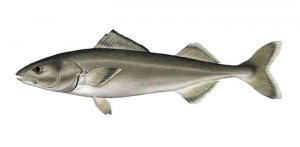Sablefish Sizes
The size of the sablefish (Anoplopoma fimbria) lengthwise can reach 42 in (107 cm). The weight can be over 125 lbs (57 kg). In the US it is also known as sable. Other names by which it is known are black cod and butterfish.
weight can be over 125 lbs (57 kg). In the US it is also known as sable. Other names by which it is known are black cod and butterfish.
Classification
The fish belongs to the Anoplopoma genus in the Anoplopomatidae family. It is from the Scorpaeniformes order and the Actinopterygii class. The sablefish is the only species belonging to the Anoplopoma genus.
In the United Kingdom it is known as the bluefish, coal cod and candlefish. It is called coalfish in Canada and in some parts of the US. These names are used only in a general manner. In fact, the names refer not just to different sizes of sablefish, but various kinds of species.
Habitat and Distribution
The fish is often found along the muddy sea beds by the North Pacific. They typically swim at depths of 1000 to 9000 ft (300 to 2700 m). The fish can be found in Baja California (Mexico). They are also prevalent in parts of southern Japan. Their overall range spans thousands of kilometers.
Physical Characteristics
The sablefish is noted for its white flesh. It has a rather mild taste and comes with a soft texture. The fish is regarded as a special cuisine in various countries. After it is cooked, the texture starts to look like sea bass.
The fish can be served in various ways. Popular methods include frying, smoking, broiling, serving as sushi or baking. Research has shown that the fish is rich in long chain omega 3 fatty acids, EPA and DHA.
The sablefish have two dorsal fins, both of similar size. The tail fin is forked. The color ranges from gray to black, while the body is streamlined.
Diet and Lifespan
The size of the sablefish determines what its food will be. Its diet includes the jellyfish, squid, walleye pollock, euphausiids, sandlance, eulachon, Pacific cod, capelin and herring. They also feed on other small fish, worms, crustaceans and salmon. It is not unusual for the sablefish to prey on fish almost as big as itself.
In terms of age the sablefish can live around 5 years or more. While the fish can go very deep, scientists have established that the young ones are often found in inshore waters.
Some of the sablefish eat their young when there are too many of them. Spawning takes place during the winter season. The eggs are left at depths of 3000 ft (900 m).
As the fish mature, they can be found near grenadiers, rattails and other fish that dwell near the sea bottom.
Behavior
The sablefish usually swim casually and with other fish species. The sablefish sometimes does this next to its prey. While swimming alongside, the fish will suddenly attack its prey and devour it.
The size of the sablefish and its exquisite taste has made it into a delicacy in many nations. However, due to overfishing, the population is now dwindling. This is one of the reasons why it is now recognized as an endangered species.





